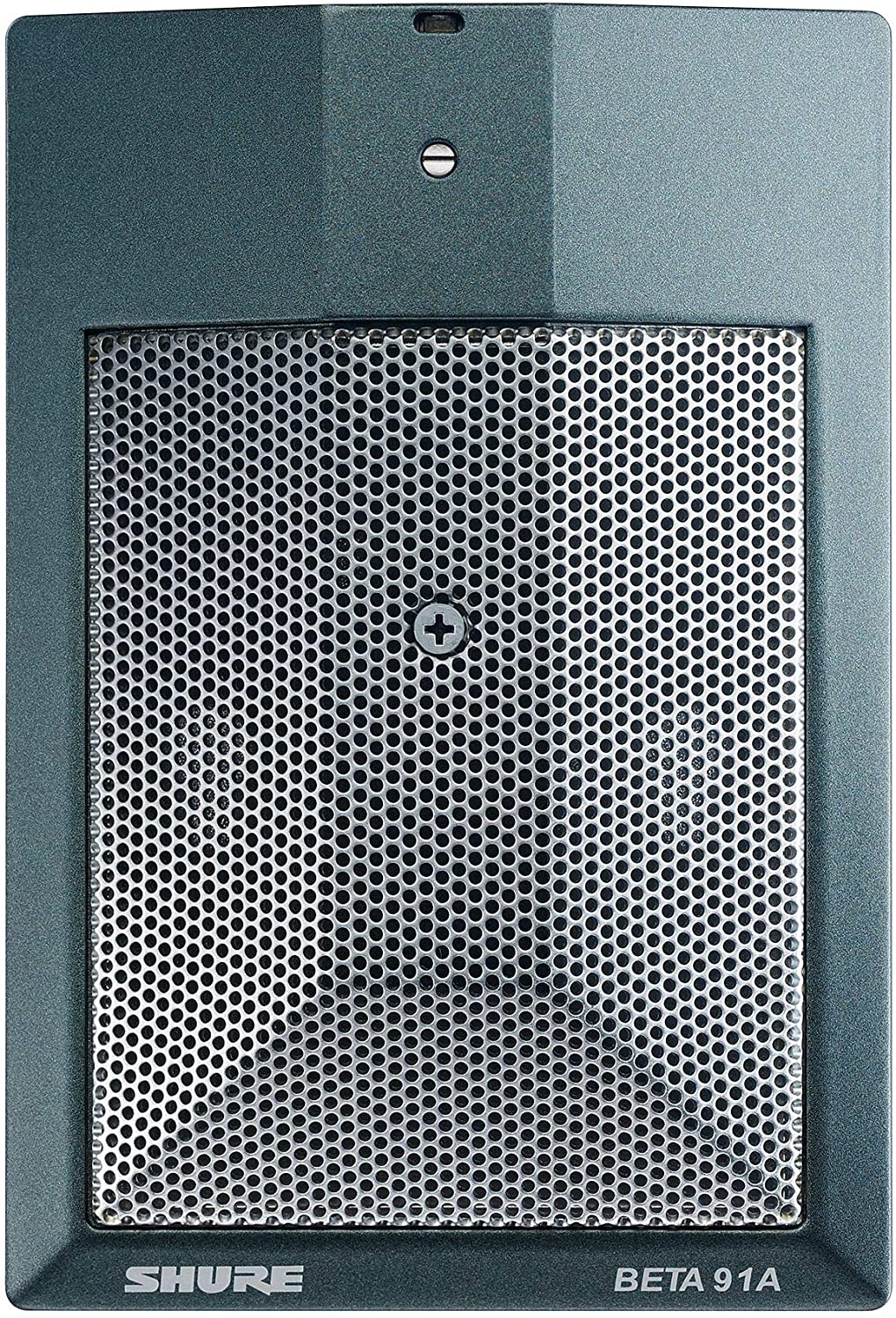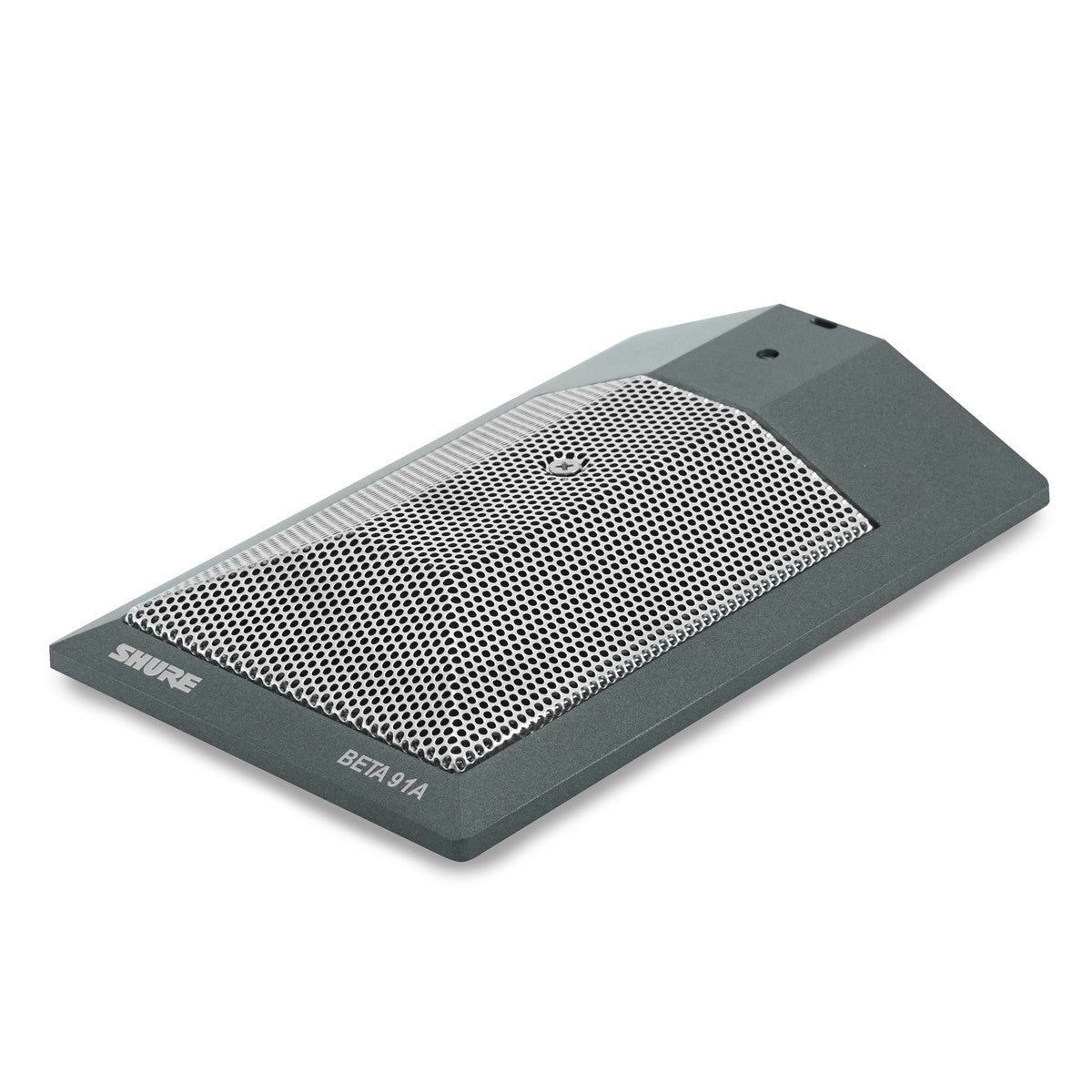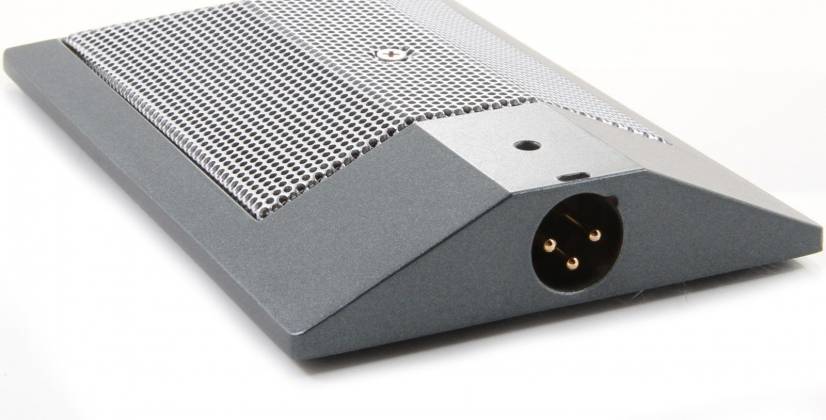Description
The Beta 91A features a new and updated microphone capsule. The new capsule will result in a more natural high frequency response than the Beta 91.
Are there any other Shure Kick Drum microphones?
The Beta 52A is a super cardioid microphone and is also suited to kick drums. With the Beta 52A you can expect even more low end.
- Uniform half-cardioid polar pattern for maximum gain-before-feedback and rejection of off-axis sound
- Precision-engineered low-profile design features integrated preamplifier and XLR connector to maximize setup efficiency while minimizing stage clutter
- Frequency response tailored for kick drum/low frequency applications with a wide dynamic range for use in high SPL environments
- Two-position contour switch to maximize attack and clarity depending on application – select the flat response setting for natural sound in most applications or the “low-mid scoop” setting for a strong low frequency “punch” with plenty of higher frequency attack
- Requires no external mounting
General Description
The Shure Beta 91A is designed for use with kick drums, piano and other traditional low frequency applications. Tailored for bass-heavy environments, this microphone features a powerful low frequency response and integrated preamplifier and XLR connection for easy setup and minimal stage clutter. The Beta 91A combines superior attack and punch for studio-quality sound, even at extremely high sound pressure levels (SPLs).
Features
- Premier live performance microphone with Shure quality, ruggedness, and reliability
- Uniform half-cardioid polar pattern (in the hemisphere above mounting surface) for maximum gain before feedback and rejection of off-axis sound
- Tailored frequency response for kick drums and bass-heavy instruments
- Wide dynamic range for use in high SPL environments
- Two-position contour switch enhances attack and clarity
- Integrated preamp and XLR connector reduce stage clutter and provide a quick, secure setup
- Low profile design requires no external mounting hardware
- Steel grille and die-cast metal construction resist wear and abuse
Applications
General Rules for Use
This table lists the most common applications and placement techniques. Keep in mind that microphone technique is largely a matter of personal taste; there is no one "correct" microphone position.
- Aim the microphone toward the desired sound source; angle unwanted sounds toward its null point.
- Use the fewest amount of microphones as practical to increase the Potential Acoustic Gain and prevent feedback.
- Follow the 3 to 1 Rule by spacing each microphone by at least three times the distance to its source to reduce Phase Cancellation.
- Place microphones as far as possible from reflective surfaces to reduce Comb Filtering.
- When using directional microphones, work closely to the microphone for extra bass response to take advantage of Proximity Effect.
- Avoid excessive handling to minimize pickup of mechanical noise and vibration.
- Do not cover any part of the microphone grille, as this will adversely affect microphone performance.
Applications and Placement
Location and room acoustics strongly affect the sound quality of microphones. To achieve the best overall sound for a particular application, it may be necessary to experiment with microphone placement and room treatments.
| Application | Suggested Microphone Placement | Tone Quality |
|---|---|---|
| Kick Drum | Inside drum, on a pillow or other cushioning surface, 25 to 152 mm (1 to 6 in.) from beater head. | Full, natural sound. |
| Contour switch activated; 25 to 152 mm (1 to 6 in.) from beater head. | Sharp attack; maximum bass “punch.” | |
| Piano | Mount microphone on underside of lid over lower treble strings. Experiment with lid height and placement to hammers for desired sound. | Bright, well-balanced, strong attack; excellent isolation. |
| Mount microphone vertically on the inside of the piano frame, near the apex of the piano’s curved wall. | Full, natural; excellent isolation and minimal hammer and damper noise. |
Mounting the Microphone
If desired, attach the microphone to a prepared surface using the mounting holes on the bottom of the microphone.
Half-cardioid Polar Pattern
This boundary microphone has a cardioid polar pattern in the hemisphere above the mounting surface. Keep sound sources within a 60° range above this surface.

Contour Switch

A two-position switch on the bottom of the microphone lets you selectively filter the low-mid frequency response without additional tools. Use this filter to enhance the attack and clarity of bass-heavy instruments.
Flat response: Provides the most natural sound in most applications.
Low-Mid Scoop: This setting tailors the microphone’s frequency response to provide a strong ‘punch’ in the low frequencies, and plenty of attack in the higher frequencies.
Load Impedance
Maximum SPL capability, output clipping level, and dynamic range vary with the input load impedance of the preamplifier to which you connect the microphone. Shure recommends a minimum input load impedance of 1000 Ω. Most modern microphone preamplifiers meet this requirement. Higher impedance results in better performance for these specifications.
Power Requirements
This microphone requires phantom power and performs best with a 48 Vdc supply (IEC-61938). However, it will operate with slightly decreased headroom and sensitivity with supplies as low as 11 Vdc.
Most modern mixers provide phantom power. You must use a balanced microphone cable: XLR-to-XLR.
Accessories
Furnished Accessories
| Zippered Carrying Bag | 95A2314 |
Optional Accessories
| 25 foot (7.5m) Triple-Flex® Microphone XLR Cable with Switchcraft connectors | C25E |
Replacement Parts
| Cardioid Cartridge | RPM98A/C |
Specifications
Type
Electret Condenser
Frequency Response
20 to 20,000 Hz
Polar Pattern
Half-cardioid (cardioid in hemisphere above mounting surface)
Output Impedance
150 Ω
Sensitivity
at 1kHz,open circuit voltage
-48.5 dBV/Pa(3.8 mV) [1]
Maximum SPL
1 kHz at 1% THD [2]
| 2500 Ω load | 155 dB |
| 1000 Ω load | 151 dB |
Signal-To-Noise Ratio [3]
64.5 dB
Dynamic Range
at 1kHz
| 2500 Ω load | 125.5 dB |
| 1000 Ω load | 121.5 dB |
Clipping Level
20 Hz to 20 kHz, at 1% THD
| 2500 Ω load | 12.5 dB |
| 1000 Ω load | 7.5 dB |
Self Noise
equivalent SPL, A-weighted, typical
29.5 dB SPL-A
Common Mode Rejection
(20 Hz to 200 kHz)
≥55 dB
Frequency Contour Switch
7 dB of attenuation centered at 400 Hz
Power Requirements
11–52 V DC phantom power [4] , 5.4 mA
Polarity
Positive pressure on diaphragm produces positive voltage on pin 2 with respect to pin 3
Weight
470 g(16.6 oz.)
Connector
Three-pin professional audio (XLR), male, balanced
[1] 1 Pa=94 dB SPL [1] 1 Pa=94 dB SPL [1] 1 Pa=94 dB SPL [1] 1 Pa=94 dB SPL [1] 1 Pa=94 dB SPL
[2] THD of microphone preamplifier when applied input signal level is equivalent to cartridge output at specified SPL [2] THD of microphone preamplifier when applied input signal level is equivalent to cartridge output at specified SPL [2] THD of microphone preamplifier when applied input signal level is equivalent to cartridge output at specified SPL [2] THD of microphone preamplifier when applied input signal level is equivalent to cartridge output at specified SPL [2] THD of microphone preamplifier when applied input signal level is equivalent to cartridge output at specified SPL
[3] S/N ratio is the difference between 94 dB SPL and equivalent SPL of self-noise, A-weighted [3] S/N ratio is the difference between 94 dB SPL and equivalent SPL of self-noise, A-weighted [3] S/N ratio is the difference between 94 dB SPL and equivalent SPL of self-noise, A-weighted [3] S/N ratio is the difference between 94 dB SPL and equivalent SPL of self-noise, A-weighted [3] S/N ratio is the difference between 94 dB SPL and equivalent SPL of self-noise, A-weighted
[4] All specifications measured with a 48 Vdc phantom power supply. The microphone operates at lower voltages, but with slightly decreased headroom and sensitivity [4] All specifications measured with a 48 Vdc phantom power supply. The microphone operates at lower voltages, but with slightly decreased headroom and sensitivity [4] All specifications measured with a 48 Vdc phantom power supply. The microphone operates at lower voltages, but with slightly decreased headroom and sensitivity [4] All specifications measured with a 48 Vdc phantom power supply. The microphone operates at lower voltages, but with slightly decreased headroom and sensitivity [4] All specifications measured with a 48 Vdc phantom power supply. The microphone operates at lower voltages, but with slightly decreased headroom and sensitivity

Estimate shipping
Refund Policy
We have a 30-day return policy, which means you have 30 days after receiving your item to request a return.
To be eligible for a return, your item must be in the same condition that you received it, unused, with all accessories and in its original packaging. You’ll also need the receipt or proof of purchase.
To start a return, you can contact us at boutique@seconcept.com. If your return is accepted, we’ll send you a return shipping label (at your expenses) as well as instructions on how and where to send your package back. Items sent back to us without first requesting a return will not be accepted and not refunded.
You can always contact us for any questions prior to purchase by email at: boutique@seconcept.com.
Damages and issues
Please inspect your order upon reception and contact us immediately if the item is defective, damaged or if you receive the wrong item, so that we can evaluate the issue and make it right.
Exceptions / non-returnable items
All Returns must contain all associated packaging and materials (ie accessories, manuals, wires, etc). Merchandise that is not returned in brand-new condition, including damages, abuse, marks, showing wear, or with missing packaging or accessories, will be subject to additional charges. Shipping and Handling charges (delivery and return) are non-refundable, including any shipping fees not directly incurred that are part of a free shipping promotion. Any items packaged with software, including but not limited to, DJ Controllers, Audio Interfaces, etc., must be returned with the original software disc including serial number and proof of deactivation.
We cannot accept returns on liquidation, special orders, liquid, needles, parts, used, sales, open box item or gift cards.
Exchanges
The fastest way to ensure you get what you want is to return the item you have, and once the return is accepted, make a separate purchase for the new item.
Refunds
We will notify you once we’ve received and inspected your return, and let you know if the refund was approved or not. If approved, you’ll be automatically refunded on your original payment method. Please remember it can take some time for your bank or credit card company to process and post the refund too.






